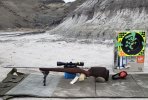OK, say you are turning 1 1/16" diameter. 75SFM is fairly conservative for barrel steel with HS tooling, considering the weight and rigidity of what many use for a "gunsmithing lathe". 75SFM at an 1 1/16"dia. translates to 270RPM! 50-75RPM is just loping along! Even if you are threading @50SFM, that's about 180RPM. (these are numbers for high speed steel tooling). "Match" chambers are really not done "SLOW". A 'match chamber' usually only has different dimensions than SAAMI (a longer or shorter throat or maybe at a different angle, a tighter neck diameter). "SLOW" just means the tool rubs more than it cuts. I can pretty much say, that when a chamber is cut the "old fashioned way", by cutting a short ways, withdrawing the reamer and cleaning it and the 'hole', re-lube and then cut again, the reamer gets 'rubbed' to death over time, the edges don't dull from cutting but from rubbing. I have been running a low pressure muzzle flush system since before it became popular and have reamers which have cut 15+ chambers and are still cutting strong! After 15-17 chambers I send 'um to Dave for a re-sharpening if they need it or not!




